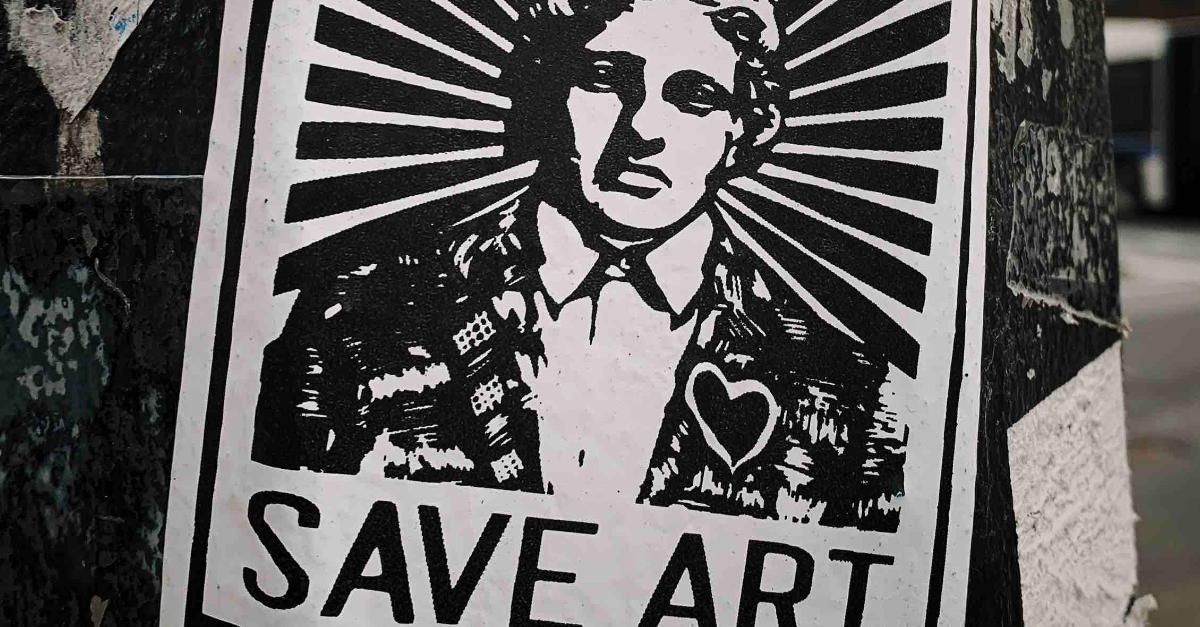Hic et nunc (“Here and now”) is the first Tezos-based NFT marketplace. It was launched on March 1st 2021 by Rafael Lima as open-source project as experiment with creative economies. Within the first months HEN (how most people call it Hic Et Nunc) could show a massive growth in active users and surpassed 100,000 objects minted by the artists.
The HEN community is a diverse of creators and artists from all over the world. The HEN Community is very active and self-organizing events or initiatives. Twitter has become the main channel for the community. The artists on Hic et nunc are creating a broad range of art, as HEN is not curated and the costs (~ gas fee, storage fee) for minting NFTs on the Tezos blockchain are very low, so that experimentation is affordable for many artists. You can find well-known artists besides unknown talents presenting their artworks on HEN.
The HEN user interface is absolutely minimal and the design is clean. The artworks automatically are in the center of attention. There are no community features which you might know from other platforms and even some comfort features (like sorting or grouping your own artworks) are missing. This puristic design and the fact, that it’s hard to explore the content presented on HEN is perhaps one ingredient of the HEN special sauce. Many users speak about the experience like in the early internet times or a ‘rabbit hole‘ experience. The people who stumbled upon HEN needed to dig into the HEN-universe, learned to improvise (due to a lack of typical features) and re-organized themselves on platforms like Twitter, when it’s about communication or interaction.
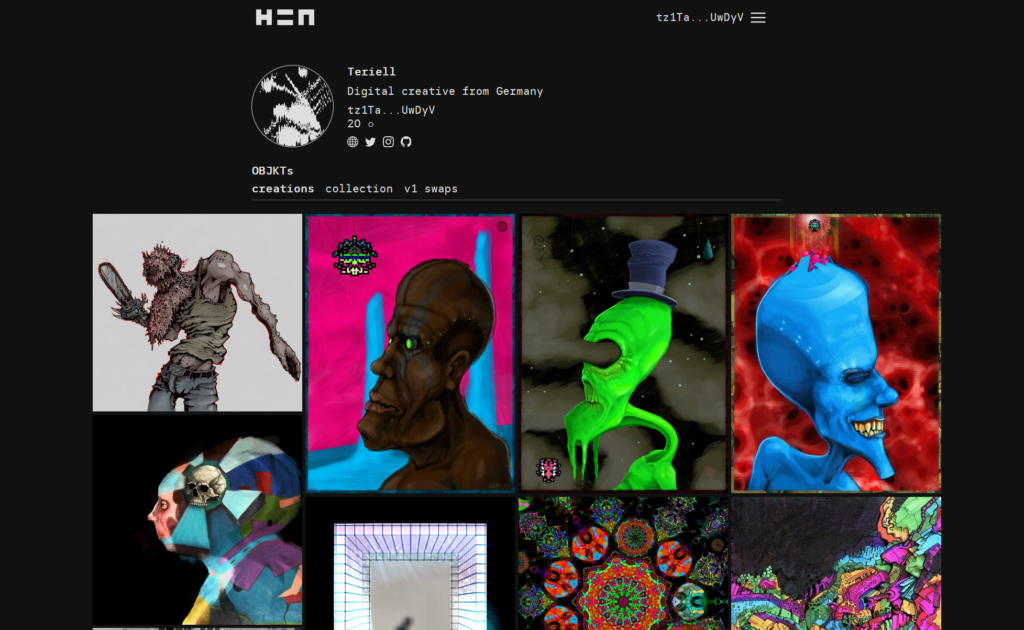
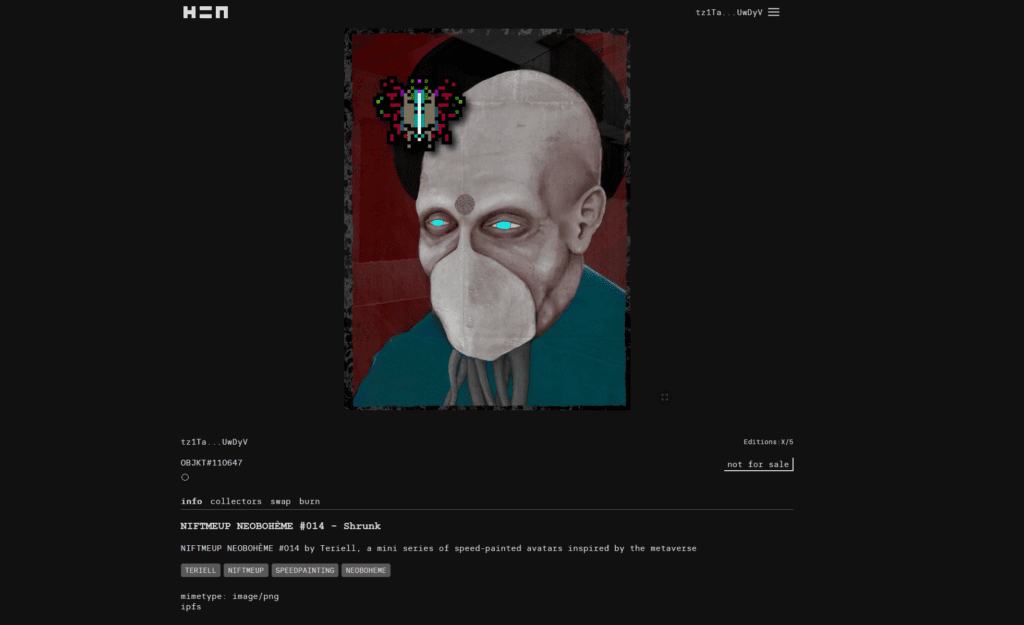
HEN Tooling
Many of the HEN artists are coders as well. That is not surprising due to two aspects: 1. HEN is an open-source project and 2. a broad range of art or creative experiments can be minted, like code-based artworks (e.g. generative interactive objects). During the last weeks and months many tools were built in the context of the Hic Et Nunc community, which finally means, that the Hic Et Nunc enhancements are not only happening on https://www.hicetnunc.xyz alone, but also through many helpful tools, gallery websites or mashups (where Tezos-based and Ethereum-based NFTs can be viewed or used).
Some great tools or tool-collections in the HENIVERSE:
- https://www.hicetnunc.tools/ got initially built and curated by @pamicel who then made an open-source project out of it –> https://github.com/Pamicel/hictool-backend & https://github.com/Pamicel/hictool-frontend
- During the Hicathon a group formed to engage with tool-builders, the community and to educate on tools, the Twitter account for this is @HicetnuncTools
- There is a git repository where a list of mentionable HEN tools is listed as well –> check it out here
- @marchingsquare published the Hicdex, which is availabe via github as well. Based on this efforts, builders can use a blockchain indexer and GraphQL API for hicetnunc to create own dashboards, dApps or mashups.
- Many gallery websites / apps integrated with HEN, good examples are oncyber.io for the creation of virtual galleries (supporting Tezos and Ethereum NFTs) or galleseum.com where artists and collectors can show their NFTs
- Projects like objkt.bid added auctions & bidding capabilities to the HEN NFT space
… so you can see, that there is a lot of activity around the core, which is HEN.
Minting and swapping of an OBJKT via HEN
Artworks can be ‘minted’ on Hic Et Nunc based on smart contracts running on the Tezos blockchain. The various NFT platforms like OpenSea, Rarible, Hic Et Nunc or Kalamint (another Tezos-based platform) are offering different features connected to the minting and selling of NFTs.
NFTs minted via HEN can be enriched with some descriptive metadata (title, description, tags), a number of editions and a preset royalty fee. If you want to sell one of your artworks based on editions, then you can define the amount easily during the minting. But it’s possible to lower this edition number afterwards by ‘burning’ a certain amount of editions. Royalties define the fee (relative to a prize, so 10% for instance) which will always go to the author of a work / the artist, once a piece will be sold on secondary market. So if a collector bought one of your editions of a work and resells it at a higher prize tag, then you will receive the percentage of that prize on any sale. This allows artists to built up some passive income streams through secondary market, which can be compared with a fair share.
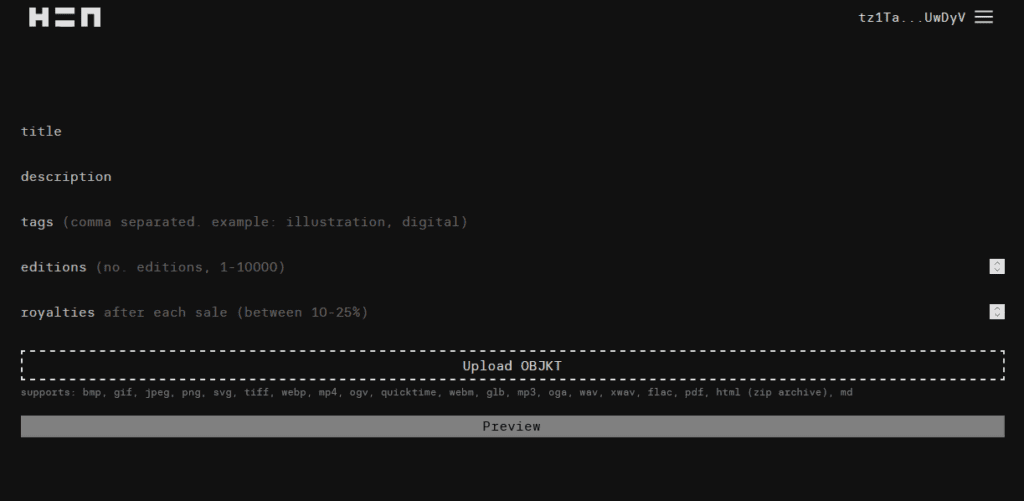
Swapping an OBJKT means, that you put a certain amount of editions of an artwork on sales. You are able to define the number of editions you want to sell for a prize (in XTZ / tezzies). Collectors then can purchase the swapped edition(s).
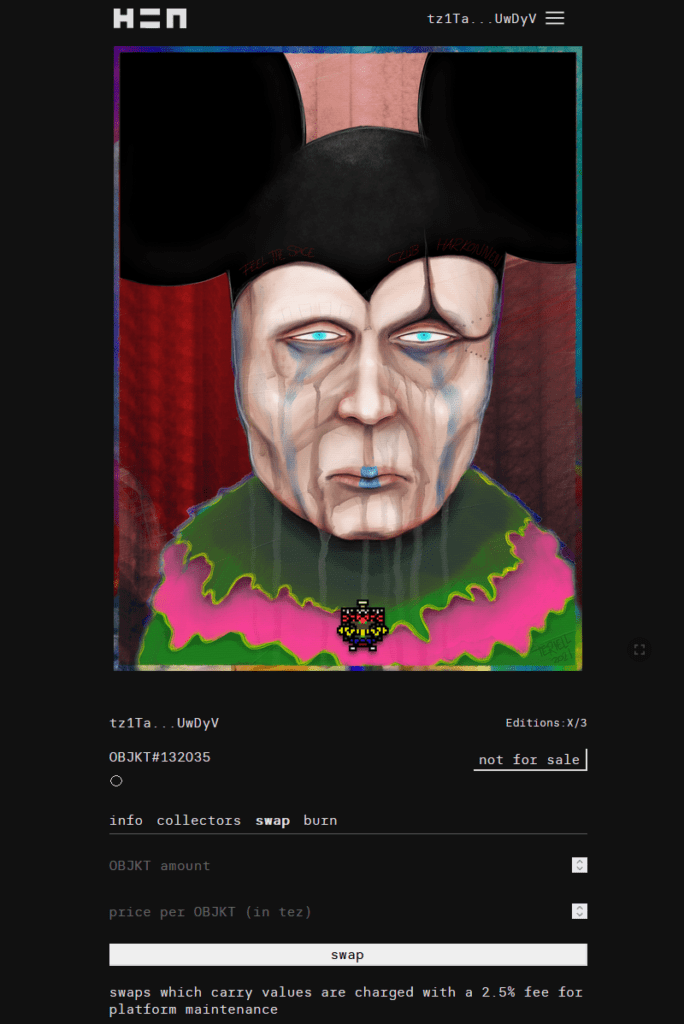
To be able to set up your profile on HEN, to mint and swap your art, you need a Tezos-wallet, for instance the Temple Wallet, which you can also use in your browser. Ethereum-wallets cannot be used here, and it’s not possible to use ETH for the minting on the Tezos-based NFT platforms. This means, that you need a certain amount of XTZ in your Tezos-wallet to start minting your NFTs via HEN. The same is true for collectors. If you want to collect a (non-fungible, Tezos-based) Token, you need XTZ and a wallet, where your tokens can be assigned with. The costs for any kind of transaction are not high. Some fees (gas + storage) are connected to the pure blockchain transations. Other fees are connected to the service, like 2.5% for swapping (see the image above), which is a share to re-fund the work and maintenance of the service. Compared to Ethereum, the costs connected to the Tezos-blockchain are extremely low.
The low costs connected to Tezos-NFTs are creating some very positive side-effects. First, creators are more experimental with their NFTs, because it’s affordable. Secondly, the low prize means that barriers are lowered for people with low income or artists from countries, where the income is lower than in rich countries. Both is very good for inclusion, low-barrier participation, diversity and for making art accessible for everyone.
clean NFT?
With an eye on climate and the environment, not any blockchain technology is really sustainable. Even more, blockchains which are connected to intensive mining based are consuming a lot of resources and energy. In fact, this cannot be reflected as a sustainable approach.
The Tezos blockchain is not as energy-hungry for its operation as Ethereum, for instance. If you compare those blockchain which support smart contracts, then there are real differences in the way the concepts work. Tezos uses Proof-of-Stake (PoS), not Proof-of-Work (PoW) and the mining as you perhaps have heard about in the context of Bitcoin is not needed in this way. Overall there are many differences between the various blockchains, not only connected to Consensus, energy-consumption etc., but also connected to how flexible the approaches are towards future improvements.
You can read more about the energy consumption of Tezos here. To give you an impression on how much energy is needed, this chart gives a first indication …
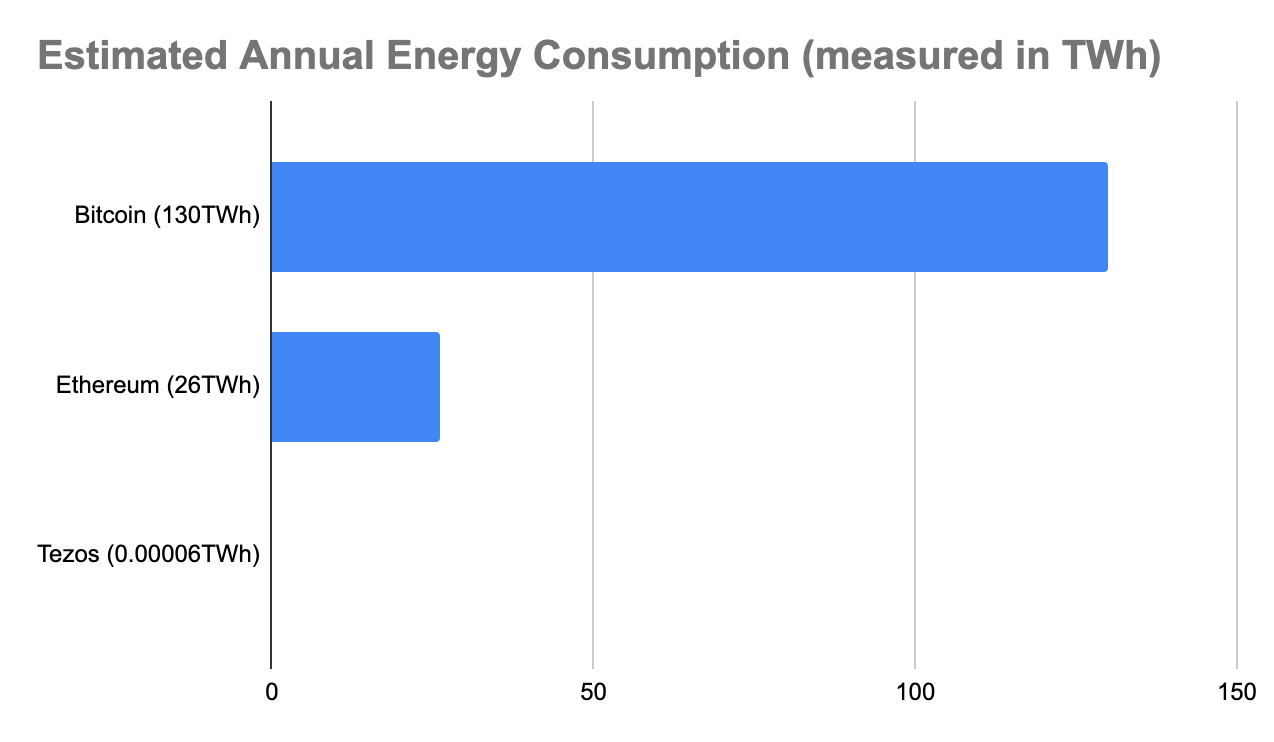
In simple words: minting an NFT on the Tezos-blockchain consumes less energy compared to the current Ethereum-blockchain. On Bitcoin this is not even possible, but it consumes dramatically more energy.
I cannot proof any numbers, but I saw in a post on that topic, that the minting of an NFT via Tezos costs as much energy as a tweet on Twitter. Again, I don’t know how much energy is needed in fact, but based on the concepts of the blockchains, the differences are obvious.
Because of this ‘low’ energy costs, the negative impact on the environment is lower. That’s why people came up with the hashtag #cleanNFT. ‘Clean’ NFTs can only be achieved, when all operations are based on carbon-neutral energy supply and based on technology (incl. hardware) which is built and operated in a sustainable way. I would not say, that this is possible today, in general. So IT cannot be clean or green today. But out of all approaches, there are good and bad concepts, energy-hungry and moderate technologies, people who care about the environment and those who don’t. Tezos is at least one of the concepts, where many aspects are done right. The overall cost-benefit-ratio needs to be reviewed on an ongoing basis of course, but for NFTs Tezos is a good place. Tezos btw. is not the only PoS-Blockchain, but with Hic Et Nunc one of the first art related platforms got established, that is built on one of the ‘clean’ blockchains.
Community action
The vital community, the diverse group of international artists and the open-source DNA of HEN are creating a very dynamic environment for new experiments and cross-border collaborations.
Activities in the community are sometimes driven by the evolution of HEN, like the Hicathon (–> Post about the hicathon via electricartifacts).
Other initiatives are connected to hashtags on Twitter, like the famous #OBJKT4OBJKT run, where artists put selected objects on sale for 0.0 or near to zero tez. It turned out that many artists today are collectors as well. Because of triggers like the OBJKT4OBJKT event, but also because they are interested in the work of fellow artists, which offer their work to affordable prizes. There are quite a few artists who collect more than they sell. I am one of those guys. It will be interesting to see, how this new kind of collector-mentality will change the art market.
As already mentioned, the HEN community is extremely active on Twitter. I would say, that Twitter is the dominant promotion channel and a place to explore new art following hashtags and connections. The other ‘main channel’ is the HEN discord. There are many channels and topics and you will find a helping hand as newbie. Also Raphael Lima is sometimes joining a discussion and in general everyone is very open-minded and caring. One ambition of the Hicathon was connected to the further evolution of HEN and the HEN community. How could a decision-making be done (e.g. related to a Roadmap or funding of development or events), how could the collaboration be brought to a next level, etc. One outcome is, that a DAO will be established for the decentralized governance.
The community is fueled by actions of many individuals and collaborating teams. To mention one example: verticalcrypto (on Twitter @verticalcrypto) is featuring HEN artists on a regular basis and contributing in many other events. Without the effort of all the individuals, HEN would only be a tool. But it isn’t. The tool somehow started some sort of movement. A movement which is gravitating around art, but also driven by ideals like inclusion, diversity and sustainability.
All in all, the community surrounding HEN is very active, open for collaboration and experimentation and consists of many engaged individuals between art, code and curiosity. HEN is not exclusive, but inclusive and has a growing number of users from all over the world. That makes the HEN community special and it will be interesting to see, how this story will be continued … for now it was just a beginning …
… we will keep in touch and will share updates here on createbar.xyz
